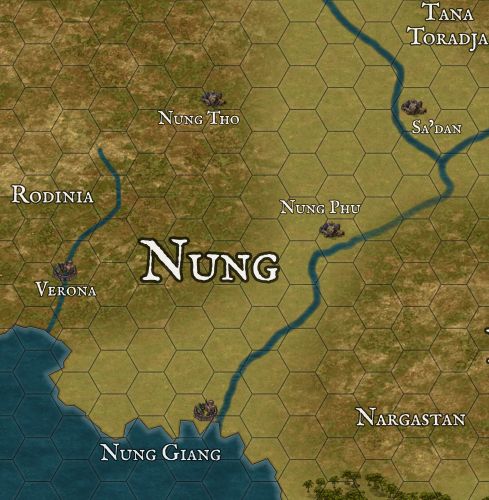Nung
The Nung are an agricultural village based people who typically live in thatched houses raised on stilts. They use slash and burn techniques to cultivate valleys and terraces on hillsides, producing chiefly rice and corn; they also exploit the upland forests. They have a strong textile, handicraft and folk culture tradition. In dress they favour the colour indigo, associated with loyalty and fidelity. Their religion centers mainly on ancestor worship but also includes and eclectic mix of beliefs in spirits and deities.
The country of Nung's population is about 80% Nung and the rest are Rodinian, Nagastani, or other ethnic groups. The official language is Nung, but Rodinian and Nagastani are also widely spoken. The Nung have a written language called Nom Nung, which has prevailed for five hundred years.
The country of Nung is divided into four provinces: Nung Xuong, Nung An, Nung Loi, and Nung Chao. Each province has its own governor appointed by the Rodinian emperor, but also has a local council of elders who represent the interests of the Nung people. The capital city is Nung Giang, located on the coast and the mouth of the Giang River. It is a bustling trade center and a cultural hub, where the Nung celebrate their festivals and traditions.
The country of Nung has a subtropical climate, with hot and humid summers and mild and dry winters. The country is rich in natural resources, such as rice, corn, fruits, vegetables, timber, fish, and minerals. The Nung are skilled farmers, fishermen, and craftsmen, who produce various handicraft products from weaving, metal working, paper making, and tile making.
The country of Nung has a complex and diverse culture, influenced by the Rodinian, Nagastani, and other neighboring cultures. The Nung have a rich folk culture of songs and music, especially the sli, which are alternative songs sung by young men and women to express their love and feelings. The Nung also have a variety of dances, games, stories, and legends, which reflect their history and identity. The Nung are known for their indigo clothing, which symbolizes loyalty and fidelity. The Nung’s religion is mainly based on ancestor worship, but also includes an eclectic mix of beliefs in spirits and deities, such as the Mother Goddess, the Dragon King, the Mountain God, and the Sun God. The Nung celebrate many festivals throughout the year, such as the New Year, the Harvest Festival, the Thanh Minh Festival, and the Mid-Autumn Festival.


